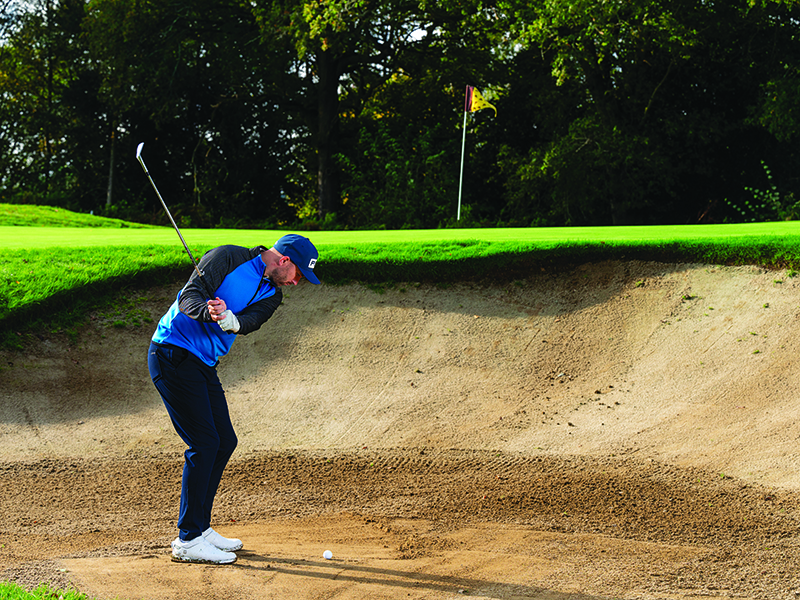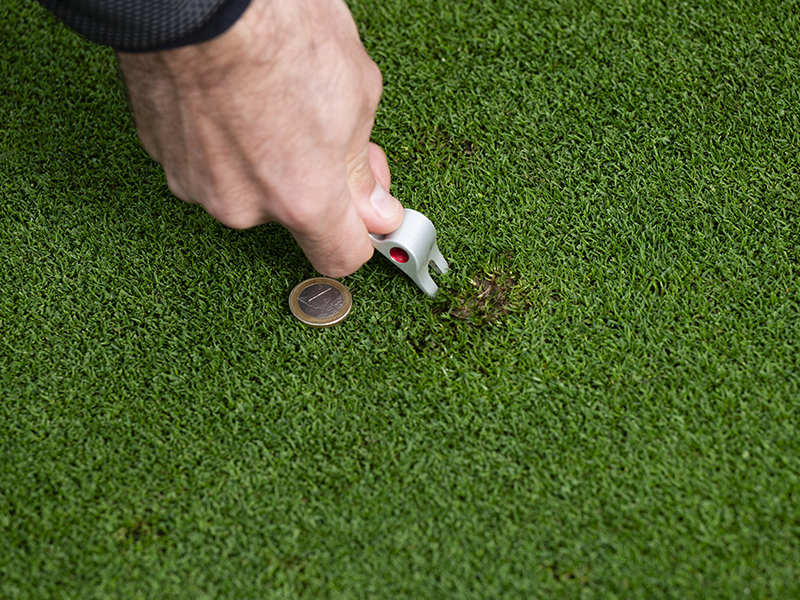
The opportunity to play some winter golf over the colder months is a bonus, especially when the weather has hindered your usual routine of hitting the fairways with your friends.
Providing you have the right gear, like the best winter golf shoes and some warm winter golf apparel, there really is no better way to get in shape for the upcoming 2025 season.
Winter golf does present its own challenges, however, and being prepared can help you to enjoy your round more and improve your score.
These 12 winter golf hacks are a great way to adapt your game to the conditions you typically face during the off-season, but they can also help get you into good habits and hone your skills...
12 Winter Golf Hacks
1. Clean Your Grooves
Club golfers often ask me how they can get more spin on the ball. The truth is that most of the time, especially in the winter, the very same players haven’t spent time looking after their equipment.
Muddy grooves will seriously impact launch off the clubface and can decrease the amount of spin you impart by up to 50%. The relationship between ball and grooves at impact determines the shot trajectory and the control you have on landing, so be sure to clean your grooves using a tee or a towel before every shot.
2. Carry Distance Off The Tee
When playing golf in the winter, the fairways typically don’t run like they would in the summer, meaning the golf ball is stopping pretty much where it lands. Your carry distance is therefore really important and keeping the ball in the air for as long as possible will help you to gain those precious extra yards.
One way you can do this is by lofting up your driver. Most modern drivers now have this function available, and increasing the degree of loft is a great way to keep your ball soaring for longer. Another way is to raise your tee height. This will achieve the same result, but in order to prevent yourself from skying the ball, make sure you set your driver back a couple of inches at address to promote that sweeping action we are looking for.

3. Winter Golf Challenges
One of the greatest things about winter golf is that it allows us to practise on the golf course without worrying too much about our score. When conditions turn colder, the usual pressures around how far you hit your irons are less important, and instead you should focus on making your practice and on-course time competitive in other areas.
This challenge is something I used to do as a young golfer, and it really helped me to improve my distance control when playing approach shots into the green.
Imagine the green is split in two, with a line dividing the front half and the back half. The aim is to hit every approach shot past the flag and into the back zone. This might cause you to go over the back of the green on occasion, but the idea here is to prevent yourself from consistently coming up short, which is the main problem for a lot of club golfers. Try this on your own by keeping a tally on your scorecard, or challenge your mates to add a little competitive spirit to proceedings.
4. Prevent A Chunk From 50 Yards
The ground is a bit softer at this time of year, meaning the dreaded chunk comes into play for a lot of club golfers. From around 50 yards, this shot becomes a lot more common, destroying both scorecard and confidence. It often occurs when your backswing gets too narrow, meaning your arms and club come towards your body with lots of wrist hinge.
A great drill to remedy this is to make a smooth backswing with lots of width and less wrist hinge. Try to reach out and touch the clubhead with your right hand (as below). If you are unable to reach the clubhead, you know there is a good amount of width in your swing. From here, you should be able to generate a nice shallow angle of attack into the ball.

5. Chipping From Wet Lies
Wet lies are an inevitable part of winter golf, but let’s embrace the challenge instead of moaning about our misfortune. The key is to avoid digging the club into the ground. We can do this by using the bounce on our wedges effectively.
It’s important to ensure the clubface doesn’t move away too closed in the backswing and an easy way to achieve this is by setting the club slightly more open at address. You can also let your left hand weaken slightly in your grip, which will also help the clubface to open in the backswing. These two tips will help to expose the bounce and prevent you from duffing chip shots around the green.
6. Bunker Shots From Compacted Sand
After lots of rain, bunkers can become firm and we sadly lose that soft, fluffy sand we enjoy in the spring and summer. While this type of lie makes the shot more difficult, certain adjustments can increase your chances of a successful escape.
Set up with the clubface relatively square and the ball in the centre of your stance. Club selection is very important. Ideally, you want a wedge with low bounce (typically 4-6˚) to help get the leading edge to the bottom of the ball so it pops up onto the green and lands softly.

7. Dry Your Clubface Between Swings
Practice swings are an important part of your pre-shot routine, but in the winter they can lead to a very wet clubface due to the excess moisture in the grass and on the ground.
When the clubface is wet, the golf ball will slide upwards at the point of impact, making it very difficult to control the trajectory of your shots. So, make sure you keep your golf bag close by, or take your towel over to the ball with you, to ensure that you can give the clubface a quick dry between your practice swings and your actual shot.
8. Always Mark Your Ball On The Green
When playing winter golf, your ball is much more likely to stop quickly on the soft greens and this can lead to problems when it comes to putting. Mud may have accumulated on the ball, which will impact the roll and speed of your putt. It’s therefore really important to mark your golf ball every time you walk onto a green.
This will not only allow you to lift and clean your ball, but also to check whether your ball has come to rest in a pitch mark. Be sure to repair any such imperfections before placing your ball down on the green so your ball won’t deviate offline straight off the blade, leading to more holed putts.

9. Chipping Onto Wet/Slow Greens
Chipping on to slow or wet greens is part and parcel of winter golf, but that doesn’t mean you have to settle for long putts to save par. In the above situation, I need to chip across the green and slightly up the hill, so getting my pace right is going to be crucial if I want to get up and down.
One of the biggest errors that many club golfers make is taking too much loft, which often leads to them coming up short. Instead, try lofting down by taking a 9-iron rather than a pitching wedge. Keep your technique the same and you should notice the ball releasing towards the hole more.
10. Putting On Wet/Slow Greens
Putting in winter can be tricky as the greens are often a lot slower due to increased moisture on the ground. Many club golfers accelerate the through-swing in their stroke in a bid to get the ball to the hole, but this causes a loss of distance control, which can lead to three putts (or worse). Instead, try to marginally increase your backswing on longer putts.
A great drill is the leapfrog drill. The idea is to create a nice ladder of balls, with each moving incrementally further than the last to hone speed and distance control with a nice smooth stroke.

11. Layer Up Correctly
Layering on the golf course is important whenever the temperature drops, but choosing the right combination of layers to wear can be the difference between playing great golf and struggling with a stiff, restricted swing. When it’s dry but you need a little extra warmth, perhaps opt for a gilet over your mid-layer to keep your core warm while maintaining a full range of movement.
If the rain does rear its ugly head, swap your gilet out for your rain jacket. Just remember that rain jackets are great for keeping you dry, but there are plenty of other options available if you just need to protect yourself against the chill.
12. Stay Loose
It can be tough during the winter to play enough golf, but when you get the chance it’s important to prepare for your round in the right way. There are three things I do on every outing – but especially in winter – that I think could benefit club golfers and help them to stay loose on the course.
The first is to make sure you head to the practice facilities prior to walking onto the 1st tee. Hitting your first shot of the day when you are stiff and cold is not a great way to start the round, and a little warm-up will help to focus your mind. The second is to make sure you take practice swings before each shot, as this will help to keep your concentration high and manage your mobility levels.
The final tip is to drink plenty of water. Staying hydrated is a key part of performing well in any sport, and golf is no different. Take some time to top up your fluid levels and give your body a chance to perform at its highest level.
Why Not Check Out More Of Golf Monthly's Expert Golf Tips?
At Golf Monthly, we are all about helping amateur golfers to play better golf – so why not check out some of our expert tips from top players and legends of the game...







